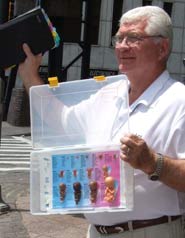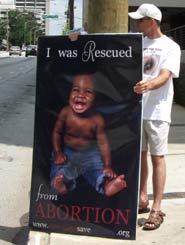by Eleanor J. Bader
To the anti-abortion movement, standing outside clinic doors and bellowing at patients and staff that they are murderers and whores is simply an effort to “stop the war against America’s children.”
Like most wars, this one has included a host of tactics, from picket lines to blockades, and has gone so far as to include arson, property damage, kidnapping and the murder of providers. The antis call it collateral damage, the end product of a campaign that has for 36 years worked doggedly to undo Roe v. Wade. From state houses to Congress, from clinics to providers’ homes, their relentless hammering has had marked victories. Since 1982 the number of providers has dropped 37 percent; 87 percent of U.S. counties have no abortion facilities, and the procedure itself is shrouded in stigma. A morass of legislative restrictions — parental consent and notification laws and pre-surgery “counseling” meant to sway women into keeping their babies—are now routine.

On a more positive note, the 1994 Freedom of Access to Clinic Entrances Act (FACE) has reduced overt violence against clinics and clinicians. Yet, it is important to remember that it has not made it extinct. In disparate places — Allentown, Pennsylvania; Charlotte, North Carolina; McAllen, Texas and Wichita, Kansas — taunts by shrieking picketers are a daily event.
A Gauntlet of Protesters
Andrea Ferrigno, Executive Director of the Whole Woman’s Health Center in McAllen, Texas, just miles from the Mexican border, describes having to walk through a gauntlet of protesters six times a week. “It’s a huge stress,” she says. “They tell us, ‘You’re too good to work here,’ and show us pictures of gory, mangled fetuses and the Virgin Mary.” Neither police nor city officials have been willing to curtail the antis’ harassing behavior.
It’s hard to imagine dealing with this for a day, let alone a decade, but Ferrigno says that the gratification she and her colleagues receive from providing comprehensive gynecological care to more than 2,000 low-income Latinas a year outweighs the negative.
Still, the presence of antis makes the clinic’s work more difficult since patients can’t help but react to being called killers, or worse. “When patients walk into the clinic, they feel as though all these eyes were on them. The protesters were so close, they feel overwhelmed. It doesn’t change their decision to abort, but it adds strain,” Ferrigno says. “Patients feel like everyone is judging them for walking into the clinic.” Not surprisingly, counselors have to work double-time to address, and then assuage, the damage.
Violence in “Quiet” Times
What’s shocking—and enraging—is that both this year and last are considered relatively quiet in terms of anti-abortion activity. In 2007, the National Abortion Federation noted one anthrax threat, 13 death threats, 19 cases of stalking, 23 suspicious packages and 181 incidents of vandalism or trespassing. During the year, several clinics were hit by arson. One, Abortion Acceptance of Albuquerque, burned to the ground.
Indeed, that the pro-choice community is cheered that the past 18 months have seen no murders, attempted murders or bombings speaks volumes about the political climate we live in.
“There’s no doubt that FACE has been successful in stemming the most severe forms of violence at clinic entrances,” says Katrina Anderson, Human Rights Attorney at the Center for Reproductive Rights’ (CRR) Domestic Legal Program. “But it has not been as effective against home pickets of clinic staff, personal threats or vandalism.”
Few know this as well as Jen Boulanger, Executive Director of the Allentown Women’s Center . Boulanger says that things in Allentown worsened in 2004, shortly after the clinic moved to a new location. A 14-foot alleyway separating the health center from its parking lot proved to be an anti-abortion dream-come-true as a public walkway on which to congregate. Led by John Dunkle — a vitriolic anti with ties to the most violent sector of the anti-choice movement — their belligerent screams can be heard in the clinic’s recovery room. Dunkle‘s colleague, and perhaps mentor, Joseph Scheidler of the Pro-Life Action League, popularized this tactic, boasting that loud noise “increases complications and confusion inside the clinic by as much as 400 percent.”

Concern for women and children? I think not.
According to Boulanger, legal action has failed to silence the Allentown protesters. What’s more, her home is the site of monthly pickets and her neighborhood has been blanketed with flyers calling her a baby killer. Local residents have also been exhorted to pressure Boulanger into leaving her post.
It hasn’t worked. “People are outraged,” Boulanger laughs. “One guy wrote Dunkle to thank him for uniting the neighborhood. He told him that everyone agrees that they don’t want him in our community.” Other sites of home protests have reported similar outcomes; apparently, people everywhere find the collision of home and professional life deplorable.
Hell and High-Water
Like McAllen’s Andrea Ferrigno, Boulanger is resolute in her commitment to the Allentown health center. “There is nothing the antis can do to get me to quit my job,” she says. Sadly, not every staffer — and not every patient whose initial intention was to end an unwanted pregnancy — is as steadfast. Despite the fact that some women have shown that they will travel through hell and high-water to terminate a pregnancy — for example, after a December 2007 arson destroyed Dr. Curtis Boyd’s clinic, Abortion Acceptance of Albuquerque, desperate patients traveled to temporary sites to keep their appointments — others are troubled by the anti-abortion rhetoric they hear and express a complicated array of emotions about the surgery.
This is true even among people who consider themselves feminists. Ellen C., a New York City university professor, says that she was shocked by the shame she felt when anti-abortion protesters berated her as she entered a clinic. “I’d been pro-choice for my entire adult life and was a women’s rights activist as an undergrad. Still, when I saw the protesters out there — and I’d been warned by my doctor about them beforehand — I felt ashamed, like trash. Even though I knew that having an abortion was the most responsible decision I could make, I still felt like a personal failure.”
Ellen is not an aberration, and clinic staff report that extricating the antis’ message from patients’ hearts and heads is at the crux of reproductive health care in the 21st century. “Sometimes women come in thinking that abortion is bad but that they need to have one anyway,” Dr. Boyd explains. “We spend a lot of time before surgery talking about moral and ethical choices. We ask them what they believe, what their God is like. We go through the pros and cons of each decision and help them look at their lives and make a choice based on what is best for them.” The process, he continues, helps patients grapple with abortion as a rational option, a perspective they otherwise rarely hear.
Boyd’s clinic — like virtually all others — offers post-abortion counseling so that residual doubts and feelings of guilt can be discussed. In addition, regular staff meetings allow workers to discuss what it means to work in a field where blockades, picket lines, fires, stalking, hate mail, online threats, taunts and even murder have precedent.
Unmeasured Toll Drains Personal Resources
“The toll violence or the threat of violence takes on providers is enormous,” says CRR attorney Katrina Anderson. “First, there’s the economic burden of installing and maintaining security cameras and barriers. Then there’s the hiring of security officers. Patients are impacted because entering a clinic is like walking into a jail as opposed to walking into any other health facility. Lastly, interactions with protesters can range from annoying to traumatic.”
Couple this with a legislative assault that continually seeks to impose restrictions on providers, and you have a picture of the morass now facing U.S. women. What gets lost in the mix is the reality that abortions will happen whether or not they’re legal, albeit with more ambivalence. Feelings of shame are also potent, causing women of all races, ages, classes and educational levels to keep the surgery to themselves and not discuss it with friends or family. Implicit is that they should be ashamed of contraceptive failure or, perhaps, of screwing up.
For longtime clinic consultant Ruth Arick, challenging the stigma that separates abortion from other types of health care is imperative. “In many communities, the problem is not bombs, guns or even picketers. It’s the stigma that comes from the fact that we don’t discuss abortion openly,” Arick begins. “People who work in abortion care, including doctors, are seen by many as bad. And women who have abortions? Look, they may have made a mistake. If there are protesters, even if they’re quietly praying outside the building, patients get the sense that they’ve done something wrong. This forces counselors to focus on what’s happening outside the clinic as they simultaneously focus on the inside.”
Amy Hagstrom Miller, owner of four Texas clinics, agrees. “Forty-three percent of U.S. women have abortions before age 45,” she says. “I tell this to every patient because they don’t see abortion as a normal part of women’s reproductive lives. Because of the protests against abortion, people think it’s outside the field of legitimate healthcare.”
So what’s to be done? Although some activists and providers believe that the anti-abortion movement can only be eradicated by a social transformation that eliminates misogyny, Arick and Miller believe that incremental steps to change negative attitudes about abortion can be taken. “There’s less stigma about divorce and inter-racial marriage today,” Arick says. “If people knew the complex circumstances of women facing unwanted pregnancies, it would go a long way in helping them understand those who have abortions as well as those who provide them.”
Eleanor J. Bader is a teacher, freelance writer and activist from Brooklyn, NY. She is the co-author of Targets of Hatred: Anti-Abortion Terrorism (Macmillan 2001).
